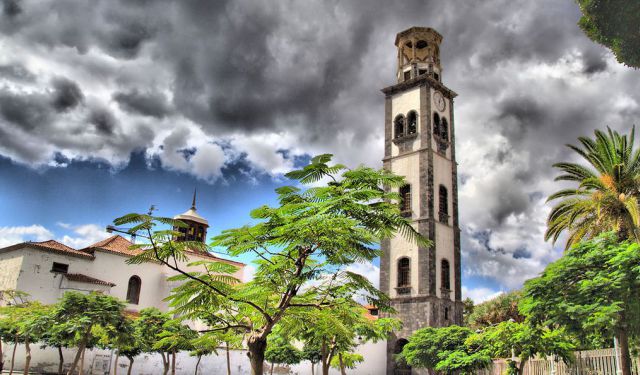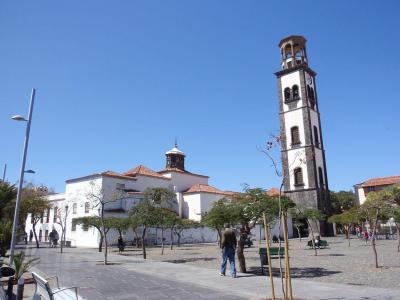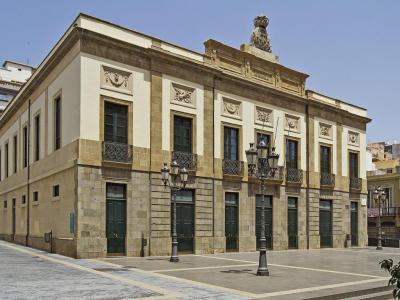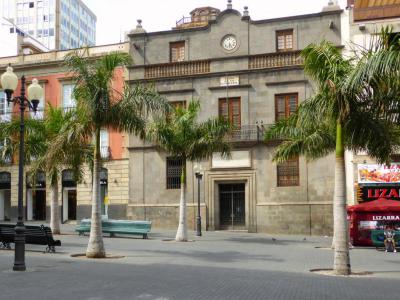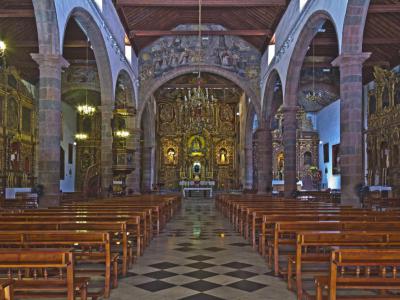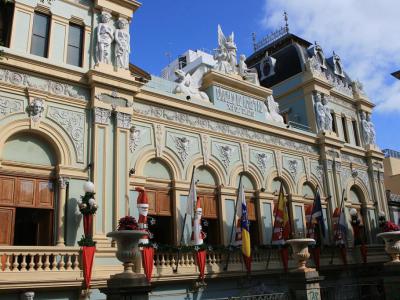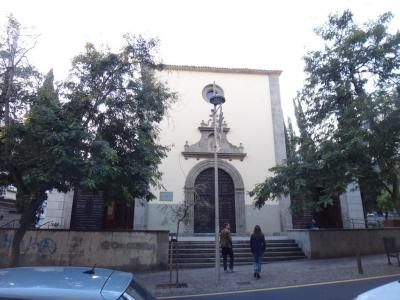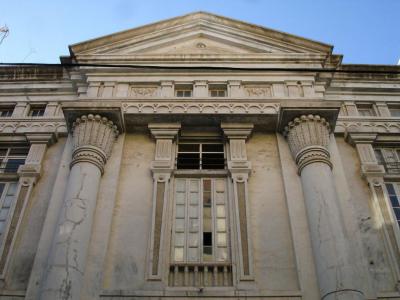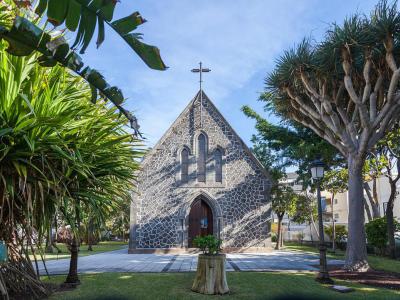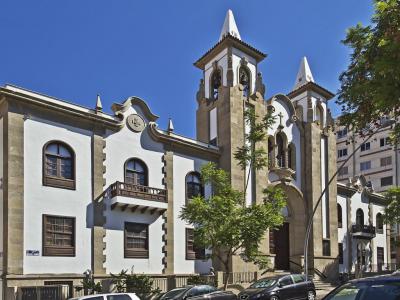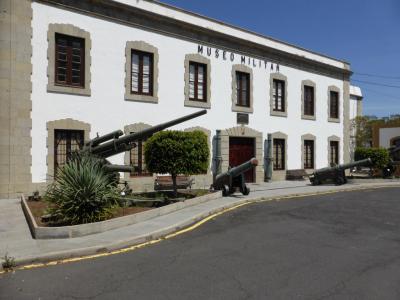Santa Cruz de Tenerife's Historical Buildings (Self Guided), Santa Cruz de Tenerife
One has to admit that the Tenerife capital has preserved its historical buildings in great condition. History enthusiasts will find a wealth of sightseeing sites in the heart of Santa Cruz de Tenerife, each weaving a unique narrative of the city's cultural legacy.
Among these architectural gems is the Church of the Immaculate Conception, a testament to the island's deep-rooted Catholic tradition. Distinguished by its unique five naves, it is built over a conquistador chapel, blending Baroque and Tuscan styles, with a bell tower reminiscent of a minaret.
The Guimera Theatre, a revered cultural institution, is the oldest theater in the Canary Islands. With its neoclassical design and opulent décor, the venue has been providing stage for theatrical plays, ballets, orchestras, and congresses since its inauguration in the 19th century.
Another landmark, the Charter Palace (Palacio de Carta) exudes grandeur and historical significance. Originally built as a noble residence, it now garners recognition as the first protected building in the Canary Islands, boasting a distinctive blend of Baroque and Neoclassical influences.
The Church of Saint Francis of Assisi and the Church of San Jorge, along with the Church of San Jose and the Parish of Our Lady of Pilar, embody the spiritual essence of Santa Cruz, with their intricate architecture and religious significance providing solace and inspiration to worshipers and visitors alike.
For those interested in the city's fraternal history, the Circle of Friendship XII of January and the Masonic Temple offer glimpses into secret societies and their role in shaping Santa Cruz's cultural landscape.
Lastly, the imposing Almeida Castle and Military Museum remind us of the city's strategic importance throughout history, showcasing artifacts and exhibits that chronicle its military heritage.
Today, Santa Cruz de Tenerife's historical buildings stand as guardians of its past, each offering a window into the vibrant era gone by. This self-guided walk is the chance to embark on a journey through time in this captivating corner of the Canary Islands.
Among these architectural gems is the Church of the Immaculate Conception, a testament to the island's deep-rooted Catholic tradition. Distinguished by its unique five naves, it is built over a conquistador chapel, blending Baroque and Tuscan styles, with a bell tower reminiscent of a minaret.
The Guimera Theatre, a revered cultural institution, is the oldest theater in the Canary Islands. With its neoclassical design and opulent décor, the venue has been providing stage for theatrical plays, ballets, orchestras, and congresses since its inauguration in the 19th century.
Another landmark, the Charter Palace (Palacio de Carta) exudes grandeur and historical significance. Originally built as a noble residence, it now garners recognition as the first protected building in the Canary Islands, boasting a distinctive blend of Baroque and Neoclassical influences.
The Church of Saint Francis of Assisi and the Church of San Jorge, along with the Church of San Jose and the Parish of Our Lady of Pilar, embody the spiritual essence of Santa Cruz, with their intricate architecture and religious significance providing solace and inspiration to worshipers and visitors alike.
For those interested in the city's fraternal history, the Circle of Friendship XII of January and the Masonic Temple offer glimpses into secret societies and their role in shaping Santa Cruz's cultural landscape.
Lastly, the imposing Almeida Castle and Military Museum remind us of the city's strategic importance throughout history, showcasing artifacts and exhibits that chronicle its military heritage.
Today, Santa Cruz de Tenerife's historical buildings stand as guardians of its past, each offering a window into the vibrant era gone by. This self-guided walk is the chance to embark on a journey through time in this captivating corner of the Canary Islands.
How it works: Download the app "GPSmyCity: Walks in 1K+ Cities" from Apple App Store or Google Play Store to your mobile phone or tablet. The app turns your mobile device into a personal tour guide and its built-in GPS navigation functions guide you from one tour stop to next. The app works offline, so no data plan is needed when traveling abroad.
Santa Cruz de Tenerife's Historical Buildings Map
Guide Name: Santa Cruz de Tenerife's Historical Buildings
Guide Location: Spain » Santa Cruz de Tenerife (See other walking tours in Santa Cruz de Tenerife)
Guide Type: Self-guided Walking Tour (Sightseeing)
# of Attractions: 10
Tour Duration: 2 Hour(s)
Travel Distance: 2.8 Km or 1.7 Miles
Author: Sandra
Sight(s) Featured in This Guide:
Guide Location: Spain » Santa Cruz de Tenerife (See other walking tours in Santa Cruz de Tenerife)
Guide Type: Self-guided Walking Tour (Sightseeing)
# of Attractions: 10
Tour Duration: 2 Hour(s)
Travel Distance: 2.8 Km or 1.7 Miles
Author: Sandra
Sight(s) Featured in This Guide:
- Parroquia de la Concepcion (Church of Immaculate Conception)
- Teatro Guimera (Guimera Theatre)
- Palacio de Carta (Charter Palace)
- Iglesia de San Francisco de Asís (Church of St. Francis of Assisi)
- Circulo de Amistad XII de Enero (Circle of Friendship XII of January)
- Parroquia de Nuestra Señora del Pilar (Parish of Our Lady of Pilar)
- Templo Masónico (Masonic Temple)
- Iglesia de San Jorge (Church of San Jorge)
- Iglesia de San José (Church of San Jose)
- Almeida Castle and Military Museum
1) Parroquia de la Concepcion (Church of Immaculate Conception)
The Church of the Immaculate Conception is not the Cathedral of Tenerife. That honor goes to the Cathedral of La Laguna. However, the Church of the Immaculate Conception does have five naves. No other church in the Canaries has five naves. The church is built over a chapel erected by the conquistadors when they landed on the island.
Inside the church is an image of Saint James the Apostle, patron saint of Santa Cruz de Tenerife. The church holds a relic of martyred Pope Saint Clement I, donated by the Patriarch of Antioch. There is also a 15th century Gothic image of Our Lady of Consolation, patron saint of Santa Cruz de Tenerife.
The style of the church is both baroque and Tuscan. The bell tower, the stand out identifying marker of the church, closely resembles a minaret.
Inside the church is an image of Saint James the Apostle, patron saint of Santa Cruz de Tenerife. The church holds a relic of martyred Pope Saint Clement I, donated by the Patriarch of Antioch. There is also a 15th century Gothic image of Our Lady of Consolation, patron saint of Santa Cruz de Tenerife.
The style of the church is both baroque and Tuscan. The bell tower, the stand out identifying marker of the church, closely resembles a minaret.
2) Teatro Guimera (Guimera Theatre)
The Guimerá Theatre, the oldest in the Canary Islands, first opened in January 1851 and was built on the site of a former Dominican convent that had been dismantled during the Mendizábal confiscations. Designed by the Canarian architect Manuel de Oraá, its neoclassical-romantic façade is topped with the crest of Queen Isabel II.
Inside, you’ll find a sumptuous auditorium famously nicknamed “The Chocolate Box” thanks to its gilded moldings, plush velvets, frescoed ceilings, and sweeping balconied seating-drawing comparisons to The Royal Theatre. Over the years, successive renovations-in 1911, the late 20th century, and again in 2010-have modernized its facilities while preserving its historic charm. The theatre spans several performance spaces, including the main hall (roughly 800–900 seats) and the flexible “Guimerá Space” annex.
Named in 1923 for beloved native playwright Ángel Guimerá, whose works like Terra baixa and María Rosa helped transform Catalan theatre, the venue stands as a testament to Tenerife’s literary heritage. Today, it hosts theatre, cinema, concerts, dance, comedies, zarzuelas, and longstanding fixtures of the local cultural scene-including events linked to the International Canary Music Festival and the city’s Carnival.
A stroll around the plaza reveals public art and tributes: a bronze statue of Ángel Guimerá and the “Per Adriano” sculpture by Igor Mitoraj, representing the duality of tragedy and comedy.
Inside, you’ll find a sumptuous auditorium famously nicknamed “The Chocolate Box” thanks to its gilded moldings, plush velvets, frescoed ceilings, and sweeping balconied seating-drawing comparisons to The Royal Theatre. Over the years, successive renovations-in 1911, the late 20th century, and again in 2010-have modernized its facilities while preserving its historic charm. The theatre spans several performance spaces, including the main hall (roughly 800–900 seats) and the flexible “Guimerá Space” annex.
Named in 1923 for beloved native playwright Ángel Guimerá, whose works like Terra baixa and María Rosa helped transform Catalan theatre, the venue stands as a testament to Tenerife’s literary heritage. Today, it hosts theatre, cinema, concerts, dance, comedies, zarzuelas, and longstanding fixtures of the local cultural scene-including events linked to the International Canary Music Festival and the city’s Carnival.
A stroll around the plaza reveals public art and tributes: a bronze statue of Ángel Guimerá and the “Per Adriano” sculpture by Igor Mitoraj, representing the duality of tragedy and comedy.
3) Palacio de Carta (Charter Palace)
The Charter Palace was commissioned in 1721 by Captain Matías Rodríguez Carta as his grand family residence and completed in 1752. Its stone façade showcases a harmonious blend of Canarian Baroque and Neoclassical styles, with elegant balconies and a clock adorning the upper level.
Inside, the palace unfolds around two traditional Canarian courtyards. The main patio is a masterpiece of colonial domestic architecture, featuring intricately carved wooden galleries and even original floorboards beneath some of the current paved surfaces.
Over the centuries, the palace has played many roles. It housed the Captaincy General of the Canary Islands, served as the headquarters of the Civil Government, and even functioned as a bank in the mid-20th century. Today, after an extensive restoration completed in early 2023, it has found new life as both a tourist information office and the home of the Santa Cruz History Museum.
Inside, the palace unfolds around two traditional Canarian courtyards. The main patio is a masterpiece of colonial domestic architecture, featuring intricately carved wooden galleries and even original floorboards beneath some of the current paved surfaces.
Over the centuries, the palace has played many roles. It housed the Captaincy General of the Canary Islands, served as the headquarters of the Civil Government, and even functioned as a bank in the mid-20th century. Today, after an extensive restoration completed in early 2023, it has found new life as both a tourist information office and the home of the Santa Cruz History Museum.
4) Iglesia de San Francisco de Asís (Church of St. Francis of Assisi)
Church of Saint Francis of Assisi stands as a magnificent example of Canary Islands Baroque. Built originally as part of a Franciscan convent-founded in the late 17th century-the current structure was completed in 1680, showcasing a colonial facade, a Neo-Corinthian portico, and three robust toscano stone columns. Visitors are greeted by a spacious three-nave interior, vaulted arches, Mudejar wooden ceilings, and richly detailed altarpieces in Andalusian style, including the grand main retablo and several exquisitely carved side altars.
One of the most treasured elements of the church is the revered image of the Lord of Tribulations, a small 17th-century bust of Christ. This sacred figure holds deep significance in the spiritual life: during the 1893 cholera outbreak, it was carried through the city’s streets in a solemn procession, after which the epidemic mysteriously subsided. In gratitude, the people honored it with the title “Lord of Santa Cruz.”
Inside, look for the beautifully restored 18th-century retablos-particularly the impressive main altar with its ornate Salomonic columns from the old Dominican convent-and the finely painted frescoes in grisaille that frame the choir and presbytery, depicting notable figures. A historic pipe organ, dating between 1778 and 1781, adds to the sacred atmosphere, often used during Mass and special concerts in the parish.
One of the most treasured elements of the church is the revered image of the Lord of Tribulations, a small 17th-century bust of Christ. This sacred figure holds deep significance in the spiritual life: during the 1893 cholera outbreak, it was carried through the city’s streets in a solemn procession, after which the epidemic mysteriously subsided. In gratitude, the people honored it with the title “Lord of Santa Cruz.”
Inside, look for the beautifully restored 18th-century retablos-particularly the impressive main altar with its ornate Salomonic columns from the old Dominican convent-and the finely painted frescoes in grisaille that frame the choir and presbytery, depicting notable figures. A historic pipe organ, dating between 1778 and 1781, adds to the sacred atmosphere, often used during Mass and special concerts in the parish.
5) Circulo de Amistad XII de Enero (Circle of Friendship XII of January)
The Circle of Friendship XII of January is a early 20th-century social club, designed by esteemed architect Mariano Estanga y Arias-Girón and later expanded. The building exemplifies the elegant Second Empire style: its symmetrical façade with rustication, mansard-roofed corner towers, ornate balconies, and sculptural embellishments. It has been recognized as an Asset of Cultural Interest reflecting its cultural and architectural importance since December 15, 1985.
Founded in 1855 and relocated to its magnificent current quarters in 1904, the Circle began as a private society for Tenerife’s bourgeois elite. Inside, you’ll find a grand marble staircase, a 500-seat theatre, a historic ballroom, a library of over 15,000 volumes, and dedicated rooms for billiards, chess, exhibitions, concerts, and cultural events .
Today, it remains a place for artistic performances, folklore concerts, temporary exhibitions, and plays a central role during Carnival season - notably hosting zarzuela ensembles and gala events central to Tenerife’s festivities.
For tourists, the Circle of Friendship XII of January offers a unique glimpse into the island’s sociocultural heritage. Even if you’re not a member, many events-especially cultural evenings, concerts, and Carnival presentations-are open to the public.
Founded in 1855 and relocated to its magnificent current quarters in 1904, the Circle began as a private society for Tenerife’s bourgeois elite. Inside, you’ll find a grand marble staircase, a 500-seat theatre, a historic ballroom, a library of over 15,000 volumes, and dedicated rooms for billiards, chess, exhibitions, concerts, and cultural events .
Today, it remains a place for artistic performances, folklore concerts, temporary exhibitions, and plays a central role during Carnival season - notably hosting zarzuela ensembles and gala events central to Tenerife’s festivities.
For tourists, the Circle of Friendship XII of January offers a unique glimpse into the island’s sociocultural heritage. Even if you’re not a member, many events-especially cultural evenings, concerts, and Carnival presentations-are open to the public.
6) Parroquia de Nuestra Señora del Pilar (Parish of Our Lady of Pilar)
The Parish of Our Lady of the Pillar greets visitors with a graceful and refined exterior. The present structure was consecrated in 1750 during the tenure of Bishop Juan Francisco Guillén Isso. Inside, the church captivates with a vaulted main nave and two lower side chapels-features introduced during renovations in the 1960s-as well as a beautifully detailed rococo-style main altarpiece crafted in the mid-18th century.
The ornate wood ceiling, restored in late 2023, showcases Mudejar-inspired panels, while the central altarpiece stands as the Canary Islands’ first-known example of rococo artistry, complete with shelled striated columns.
Art enthusiasts should look for "Our Lady of Sorrows", affectionately nicknamed “The Republican ”-a Baroque statue by Miguel Arroyo that was uniquely allowed to process during the Second Spanish Republic in 1931. The church also houses images of the Virgin of Carmen, Christ of Mercy, the Immaculate Heart of Mary, and the Sacred Heart of Jesus.
In addition to its spiritual and artistic value, the parish played a key role in local history: after Admiral Nelson’s failed attack in 1797, it served as the meeting place for local merchants whose assembly led to the settlement being officially recognized as a town-an important step in Santa Cruz’s development into the modern city it is today.
The ornate wood ceiling, restored in late 2023, showcases Mudejar-inspired panels, while the central altarpiece stands as the Canary Islands’ first-known example of rococo artistry, complete with shelled striated columns.
Art enthusiasts should look for "Our Lady of Sorrows", affectionately nicknamed “The Republican ”-a Baroque statue by Miguel Arroyo that was uniquely allowed to process during the Second Spanish Republic in 1931. The church also houses images of the Virgin of Carmen, Christ of Mercy, the Immaculate Heart of Mary, and the Sacred Heart of Jesus.
In addition to its spiritual and artistic value, the parish played a key role in local history: after Admiral Nelson’s failed attack in 1797, it served as the meeting place for local merchants whose assembly led to the settlement being officially recognized as a town-an important step in Santa Cruz’s development into the modern city it is today.
7) Templo Masónico (Masonic Temple)
The Masonic Temple is a stunning example of Egyptian Revival architecture. Designed by architect Manuel de Cámara and Cruz for the Añaza Lodge, this impressive building was begun in 1900 and fully completed in the 1920s, with intricate detailing by local sculptors like Guzmán Compañ Zamorano. The grand façade features colossal palm-capital columns, four enigmatic sphinxes, and a radiant Eye of Providence-symbols steeped in Masonic lore and Egyptian iconography.
Beyond its architectural beauty, the temple holds a rich historical narrative. From its origins as the largest Masonic centre in Spain, hosting progressive educational lectures and social activities, the temple underwent a dramatic transformation in 1936 when it was taken over by Franco's regime, repurposed by the Falange, and eventually utilized by the military.
Resting quietly after ceasing operations in 1990, it was eventually acquired by the city in 2001 and declared a Asset of Cultural Interest in 2007. More recently, it has been recognised as a Monument to Historical Memory for persecuted individuals, including Freemasons, under Franco’s dictatorship.
Today, after a €3 million restoration, the temple is transforming into a museum dedicated to Masonry’s cultural heritage, promising immersive exhibits on Masonic symbolism, Tenerife’s intellectual legacy, and the global context of the movement.
Beyond its architectural beauty, the temple holds a rich historical narrative. From its origins as the largest Masonic centre in Spain, hosting progressive educational lectures and social activities, the temple underwent a dramatic transformation in 1936 when it was taken over by Franco's regime, repurposed by the Falange, and eventually utilized by the military.
Resting quietly after ceasing operations in 1990, it was eventually acquired by the city in 2001 and declared a Asset of Cultural Interest in 2007. More recently, it has been recognised as a Monument to Historical Memory for persecuted individuals, including Freemasons, under Franco’s dictatorship.
Today, after a €3 million restoration, the temple is transforming into a museum dedicated to Masonry’s cultural heritage, promising immersive exhibits on Masonic symbolism, Tenerife’s intellectual legacy, and the global context of the movement.
8) Iglesia de San Jorge (Church of San Jorge)
The Church of San Jorge is a captivating example of late 19th-century neo-Gothic architecture. Originally built in 1897 as an Anglican place of worship to serve the British expatriate community, its cornerstone was laid on 22 June to mark Queen Victoria’s 60th anniversary on the throne. Designed by Walter I. Wood, it features a Latin-cross floorplan, lancet windows, and a stone-cut facade framed by a steeply pitched slate roof and wooden diaphragm arches .
After a decline in Anglican attendance, the church was sold in 1989 to the Diocese of San Cristóbal de La Laguna. It reopened as a Catholic church in September 1993, consecrated to the adoration of the Blessed Sacrament under the name of San Jorge. Set within a gardened plot that includes native dragon trees and banana palms, the church offers a peaceful retreat.
Inside, visitors will find a wooden interior-exposed beams, pews, while the leaded stained-glass windows, including detailed scenes in the choir area, filter sunlight into the nave . One prominent stained-glass triptych memorializes Hugh Henry Hamilton, a key benefactor whose family financed its installation in 1908.
On the eve of the annual July 25 commemorations of the 1797 Battle of Santa Cruz, the church often hosts an ecumenical service-symbolically uniting Anglican and Catholic faiths in remembrance of those who defended the city from Admiral Nelson’s attack.
After a decline in Anglican attendance, the church was sold in 1989 to the Diocese of San Cristóbal de La Laguna. It reopened as a Catholic church in September 1993, consecrated to the adoration of the Blessed Sacrament under the name of San Jorge. Set within a gardened plot that includes native dragon trees and banana palms, the church offers a peaceful retreat.
Inside, visitors will find a wooden interior-exposed beams, pews, while the leaded stained-glass windows, including detailed scenes in the choir area, filter sunlight into the nave . One prominent stained-glass triptych memorializes Hugh Henry Hamilton, a key benefactor whose family financed its installation in 1908.
On the eve of the annual July 25 commemorations of the 1797 Battle of Santa Cruz, the church often hosts an ecumenical service-symbolically uniting Anglican and Catholic faiths in remembrance of those who defended the city from Admiral Nelson’s attack.
9) Iglesia de San José (Church of San Jose)
The Parish Church of San José de Nazaret, is a stunning neoclassical landmark, designed by local architect José Enrique Marrero Regalado and completed in 1930. The twin bell towers and simple facade reflect early 20th-century Canarian architecture, quietly standing out among modern buildings.
Step inside, and you’ll discover revered images of Saint Joseph of Nazareth (the church's patron), the Christ of Medinaceli, the Virgin of the Dove, and the Sacred Heart of Jesus. You'll also find Orthodox-style icons and an exquisite oil painting of the Virgin of la Paloma.
Beyond its visual beauty, the church holds an impressive library with Latin-printed books and missals from the late 18th and early 19th centuries, once used in liturgical celebrations before the Second Vatican Council.
Be sure to see the small plaza behind the church, Architect Enrique Marrero Regalado Square, where a statue of Saint John Bosco was added in 2016 for the 75th anniversary in the city of the Salesian community.
Step inside, and you’ll discover revered images of Saint Joseph of Nazareth (the church's patron), the Christ of Medinaceli, the Virgin of the Dove, and the Sacred Heart of Jesus. You'll also find Orthodox-style icons and an exquisite oil painting of the Virgin of la Paloma.
Beyond its visual beauty, the church holds an impressive library with Latin-printed books and missals from the late 18th and early 19th centuries, once used in liturgical celebrations before the Second Vatican Council.
Be sure to see the small plaza behind the church, Architect Enrique Marrero Regalado Square, where a statue of Saint John Bosco was added in 2016 for the 75th anniversary in the city of the Salesian community.
10) Almeida Castle and Military Museum
Regional Military Museum is located in the historic Almeida Castle completed in 1884 occupying the Almeida quarter, in the northern part of the city.
In 1854, the construction of the Fort of Almeyda was decided, and on April 21 the engineer colonel Clavijo y Plo presented his project, approved on September 22 of that year, starting the work on November 6. In 1884 the work was terminated, although by then it no longer had much military value, due to improvements in artillery techniques and population growth.
To the west it has a fort that dominates with its fires a small valley formed by the mountains that rise in its vicinity. It belongs to the Vauban system , its semicircular plan being closed by the diameter with the main facade, with two floors. To the east there is a single-storey corrugated front and a battery was built on the upper esplanade; to the north another crenellated front and three casemates with two floors; in the west three single-storey casemates and in the gorge the defensive barracks.
The Military Museum (Museo Militar) was founded in 1988 and is one of the best Canarien cartography research centers, and a great depository of armaments and objects invoking the military history of the islands, with respect to the successful defence of the city. The most referred exhibit items are the El Tigre (The Tiger) artillery-type weapon and a scale replica of the flagship Theseus. There is also an exposition dedicated to the life of Admiral Nelson, a collection of flags as well as early paintings by Canarien artists.
In 1854, the construction of the Fort of Almeyda was decided, and on April 21 the engineer colonel Clavijo y Plo presented his project, approved on September 22 of that year, starting the work on November 6. In 1884 the work was terminated, although by then it no longer had much military value, due to improvements in artillery techniques and population growth.
To the west it has a fort that dominates with its fires a small valley formed by the mountains that rise in its vicinity. It belongs to the Vauban system , its semicircular plan being closed by the diameter with the main facade, with two floors. To the east there is a single-storey corrugated front and a battery was built on the upper esplanade; to the north another crenellated front and three casemates with two floors; in the west three single-storey casemates and in the gorge the defensive barracks.
The Military Museum (Museo Militar) was founded in 1988 and is one of the best Canarien cartography research centers, and a great depository of armaments and objects invoking the military history of the islands, with respect to the successful defence of the city. The most referred exhibit items are the El Tigre (The Tiger) artillery-type weapon and a scale replica of the flagship Theseus. There is also an exposition dedicated to the life of Admiral Nelson, a collection of flags as well as early paintings by Canarien artists.
Walking Tours in Santa Cruz de Tenerife, Spain
Create Your Own Walk in Santa Cruz de Tenerife
Creating your own self-guided walk in Santa Cruz de Tenerife is easy and fun. Choose the city attractions that you want to see and a walk route map will be created just for you. You can even set your hotel as the start point of the walk.
Santa Cruz de Tenerife Introduction Walking Tour
There is archeological evidence indicating a civilization two thousand years ago in the area where Santa Cruz stands today. The indigenous people were the Guanches. The island of Tenerife was called Anazo. The famous Mummy of San Andres is an excellent silent witness to those long-ago times. Before the Spaniards there were kingdoms.
On the third of May in 1494, Castilian soldiers commanded by... view more
Tour Duration: 2 Hour(s)
Travel Distance: 3.3 Km or 2.1 Miles
On the third of May in 1494, Castilian soldiers commanded by... view more
Tour Duration: 2 Hour(s)
Travel Distance: 3.3 Km or 2.1 Miles
The Most Popular Cities
/ view all
